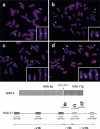The evolutionary chromosome translocation 4;19 in Gorilla gorilla is associated with microduplication of the chromosome fragment syntenic to sequences surrounding the human proximal CMT1A-REP
- PMID: 11435402
- PMCID: PMC311135
- DOI: 10.1101/gr.181101
The evolutionary chromosome translocation 4;19 in Gorilla gorilla is associated with microduplication of the chromosome fragment syntenic to sequences surrounding the human proximal CMT1A-REP
Abstract
Many genomic disorders occur as a result of chromosome rearrangements involving low-copy repeats (LCRs). To better understand the molecular basis of chromosome rearrangements, including translocations, we have investigated the mechanism of evolutionary rearrangements. In contrast to several intrachromosomal rearrangements, only two evolutionary translocations have been identified by cytogenetic analyses of humans and greater apes. Human chromosome 2 arose as a result of a telomeric fusion between acrocentric chromosomes, whereas chromosomes 4 and 19 in Gorilla gorilla are the products of a reciprocal translocation between ancestral chromosomes, syntenic to human chromosomes 5 and 17, respectively. Fluorescence in situ hybridization (FISH) was used to characterize the breakpoints of the latter translocation at the molecular level. We identified three BAC clones that span translocation breakpoints. One breakpoint occurred in the region syntenic to human chromosome 5q13.3, between the HMG-CoA reductase gene (HMGCR) and RAS p21 protein activator 1 gene (RASA1). The second breakpoint was in a region syntenic to human chromosome 17p12 containing the 24 kb region-specific low-copy repeat-proximal CMT1A-REP. Moreover, we found that the t(4;19) is associated with a submicroscopic chromosome duplication involving a 19p chromosome fragment homologous to the human chromosome region surrounding the proximal CMT1A-REP. These observations further indicate that higher order genomic architecture involving low-copy repeats resulting from genomic duplication plays a significant role in karyotypic evolution.
Figures


Similar articles
-
Evidence for involvement of TRE-2 (USP6) oncogene, low-copy repeat and acrocentric heterochromatin in two families with chromosomal translocations.Hum Genet. 2006 Sep;120(2):227-37. doi: 10.1007/s00439-006-0200-7. Epub 2006 Jun 22. Hum Genet. 2006. PMID: 16791615
-
Molecular evolution of the CMT1A-REP region: a human- and chimpanzee-specific repeat.Mol Biol Evol. 1999 Aug;16(8):1019-26. doi: 10.1093/oxfordjournals.molbev.a026191. Mol Biol Evol. 1999. PMID: 10474898
-
The 1.4-Mb CMT1A duplication/HNPP deletion genomic region reveals unique genome architectural features and provides insights into the recent evolution of new genes.Genome Res. 2001 Jun;11(6):1018-33. doi: 10.1101/gr.180401. Genome Res. 2001. PMID: 11381029 Free PMC article.
-
[Identification of the breakpoint-flanking markers on chromosomes 1 and 17 of a constitutional translocation T(1;17)(P36;Q12-21) in a patient with neuroblastoma].Verh K Acad Geneeskd Belg. 1995;57(5):389-422. Verh K Acad Geneeskd Belg. 1995. PMID: 8571670 Review. Dutch.
-
Studies on karyotype evolution in higher primates in relation to human chromosome 14 and 9 by comparative mapping of immunoglobulin C epsilon genes with fluorescence in situ hybridization.Kokuritsu Iyakuhin Shokuhin Eisei Kenkyusho Hokoku. 1999;(117):77-90. Kokuritsu Iyakuhin Shokuhin Eisei Kenkyusho Hokoku. 1999. PMID: 10859938 Review.
Cited by
-
Segmental duplications in euchromatic regions of human chromosome 5: a source of evolutionary instability and transcriptional innovation.Genome Res. 2003 Mar;13(3):369-81. doi: 10.1101/gr.490303. Genome Res. 2003. PMID: 12618367 Free PMC article.
-
Complex chromosome 17p rearrangements associated with low-copy repeats in two patients with congenital anomalies.Hum Genet. 2007 Jul;121(6):697-709. doi: 10.1007/s00439-007-0359-6. Epub 2007 Apr 25. Hum Genet. 2007. PMID: 17457615 Free PMC article.
-
2002 Curt Stern Award Address. Genomic disorders recombination-based disease resulting from genomic architecture.Am J Hum Genet. 2003 Feb;72(2):246-52. doi: 10.1086/346217. Am J Hum Genet. 2003. PMID: 12596790 Free PMC article. No abstract available.
-
Evidence for involvement of TRE-2 (USP6) oncogene, low-copy repeat and acrocentric heterochromatin in two families with chromosomal translocations.Hum Genet. 2006 Sep;120(2):227-37. doi: 10.1007/s00439-006-0200-7. Epub 2006 Jun 22. Hum Genet. 2006. PMID: 16791615
-
A high-resolution map of synteny disruptions in gibbon and human genomes.PLoS Genet. 2006 Dec 29;2(12):e223. doi: 10.1371/journal.pgen.0020223. Epub 2006 Nov 13. PLoS Genet. 2006. PMID: 17196042 Free PMC article.
References
-
- Arnold N, Stanyon R, Jauch A, O'Brien P, Wienberg J. Identification of complex chromosome rearrangements in the gibbon by fluorescent in situ hybridization (FISH) of a human chromosome 2q specific microlibrary, yeast artificial chromosomes, and reciprocal chromosome painting. Cytogenet Cell Genet. 1996;74:80–85. - PubMed
-
- Boerkoel CF, Inoue K, Reiter LT, Warner LE, Lupski JR. Molecular mechanisms for CMT1A duplication and HNPP deletion. Ann N Y Acad Sci. 1999;883:22–35. - PubMed
-
- Chen K-S, Manian P, Koeuth T, Potocki L, Zhao Q, Chinault AC, Lee CC, Lupski JR. Homologous recombination of a flanking repeat gene cluster is a mechanism for a common contiguous gene deletion syndrome. Nat Genet. 1997;17:154–163. - PubMed
-
- Dutrillaux B. Chromosomal evolution in primates: Tentative phylogeny from Microcebus murinus (Prosimian) to man. Hum Genet. 1979;48:251–314. - PubMed
-
- Dutrillaux B, Rethore MO, Prieur M, Lejeune J. Analysis of the structure of chromatids of Gorilla gorilla. Comparison with Homo sapiens and Pan troglodytes. Humangenetik. 1973;20:343–354. - PubMed
Publication types
MeSH terms
Grants and funding
LinkOut - more resources
Full Text Sources
Other Literature Sources
Medical
Miscellaneous
